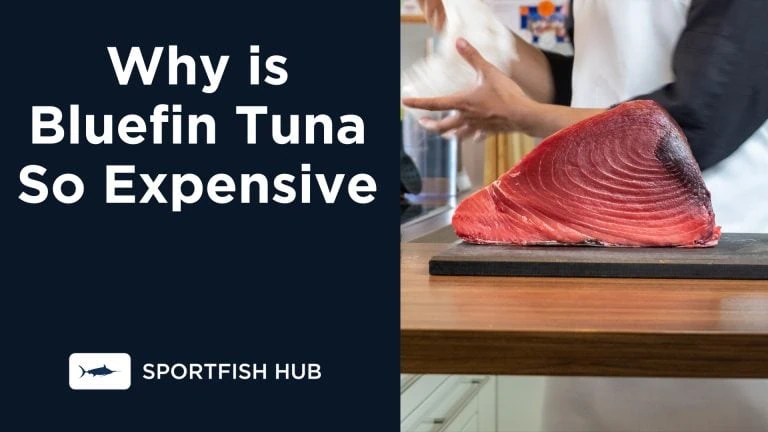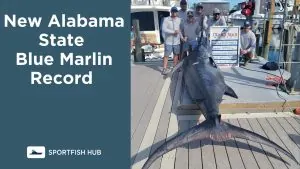Bluefin tuna, a species of fish that has become synonymous with luxury dining, especially in the form of sushi and sashimi, is known for its high price tag. But why is Bluefin Tuna so expensive?
The answer lies in a complex interplay of supply and demand, fishing regulations, and the inherent costs of the fishing industry.
- Limited Supply and Overfishing
- What is the most expensive Bluefin Tuna ever sold?
- High Demand and the Luxury Food Market
- Exporting Costs and the Fishing Economy
- Fishing Regulations and Marine Conservation
- Auctions, Marketing, and Perception
- Most Expensive Part of Tuna: The Head
- How Much Does Bluefin Tuna Cost
- FAQ
- Why is Bluefin Tuna red?
- Is Bluefin Tuna endangered?
- How can I tell if my sushi is made from Bluefin Tuna?
- Conclusion
Limited Supply and Overfishing
One of the primary reasons for the high price of bluefin tuna is the limited supply. Overfishing, illegal fishing, and the subsequent population decline of this species have significantly reduced the number of bluefin tuna in the world’s oceans.
The scarcity of this fish, particularly the Atlantic, Pacific, and Southern bluefin tuna species, has driven up its price according to the law of supply and demand.
What is the most expensive Bluefin Tuna ever sold?
The most expensive bluefin tuna ever sold was a 612-pound fish that was purchased for $3.1 million at the first New Year’s auction in Tokyo’s new fish market in 2019. The buyer was Kiyoshi Kimura, a Japanese sushi tycoon who is also known as the “Tuna King”
High Demand and the Luxury Food Market
Bluefin tuna is a highly sought-after delicacy, particularly in Asia, where it is a staple in sushi and sashimi dishes. The fish’s superior taste, texture, and nutritional value, including its status as a source of fatty tuna, contribute to its high demand and price. This demand and scarcity have positioned bluefin tuna as a luxury food item, further driving up its cost.
Exporting Costs and the Fishing Economy
The cost of bluefin tuna is also affected by the distance it has to travel from its source to the consumer. For instance, bluefin tuna from Japan, a top predator in its marine ecosystem, is considered to be of higher quality than American tuna during the peak winter months. The cost of exporting the fish from Japan, including the aspects of tuna ranching and tuna farming, can significantly drive up the price.
Fishing Regulations and Marine Conservation
Strict fishing regulations and quotas have been implemented to protect bluefin tuna populations from further decline. These regulations, part of a broader fisheries management strategy, limit the number of bluefin tuna that can be caught, further contributing to the limited supply and high price of the fish.
Auctions, Marketing, and Perception
Bluefin tuna is often sold at auctions, where the fish can command extremely high prices. In 2019, a 612-pound bluefin tuna was sold for a record-breaking $3.1 million. These high-profile sales contribute to the perception of bluefin tuna as a luxury product and drive up the price.
Most Expensive Part of Tuna: The Head
One part of the bluefin tuna that commands an even higher price than the rest of the fish is the otoro. Otoro refers to the fattiest sections of the tuna, found along the belly and underneath the head and collar.
Otoro is considered the most prized part of the bluefin for sashimi and sushi because of its rich, buttery texture and flavor. The high fat content in otoro comes from the tuna’s diet and long-distance migrations, as the fish builds up fat reserves.
The price for otoro can be astronomical, even compared to the rest of the bluefin tuna:
- Top-grade otoro sold at high-end sushi restaurants has been known to cost over $80 per piece.
- At the 2019 record-breaking bluefin auction in Tokyo, a single piece of otoro sold for over $2000.
The incredible cost of otoro is driven by:
- The tiny supply available – only a small percentage of each tuna yields the high-fat otoro cuts.
- The limited number of bluefin tuna.
- The incredible demand for this melt-in-your-mouth delicacy.
- As a result, just a few pieces of otoro can be more expensive than whole tunas.
How Much Does Bluefin Tuna Cost
| Type | Weight Range | Price Range |
|---|---|---|
| Wild Caught Pacific Bluefin | Any size | $20 – $5,000+ per lb |
| Wild Caught Atlantic Bluefin | Any size | $20 – $5,000+ per lb |
| Farmed Bluefin | Any size | $25 – $40 per lb |
| Bluefin at High-End Sushi Restaurants | Single piece | $10 – $200+ per piece |
| Bluefin at Japanese Auction | 300 lbs+ | Up to $3 million+ for whole fish |
| Bluefin from Japan | Any size | Premium pricing |
| Bluefin from Mediterranean | Any size | Premium pricing |
Key Takeaways:
- The highest value bluefin comes from wild-caught Pacific and Atlantic tuna, which can fetch over $5,000 per lb for the best quality sashimi grade.
- Farmed bluefin is less expensive at $25-$40 per lb wholesale.
- Larger tuna over 300 lbs command the highest auction prices, up to millions.
- Japanese and Mediterranean bluefin fetch premium pricing due to strong demand.
FAQ
-
Why is Bluefin Tuna red?
The red color of Bluefin Tuna meat is due to its high myoglobin content, a protein that helps deliver oxygen to muscles.
-
Is Bluefin Tuna endangered?
Yes, the Bluefin Tuna is classified as endangered by the International Union for Conservation of Nature (IUCN).
-
How can I tell if my sushi is made from Bluefin Tuna?
Bluefin Tuna has a distinctive rich, buttery flavor and a deep red color. However, it can be difficult to distinguish without asking the restaurant or sushi chef.
Conclusion
In conclusion, the high price of bluefin tuna is primarily due to the limited supply of the fish, the high demand for its taste and nutritional value, and the costs associated with catching and exporting the fish. Additionally, strict fishing regulations and high-profile auctions contribute to the perception of bluefin tuna as a luxury product, further driving up its price.













